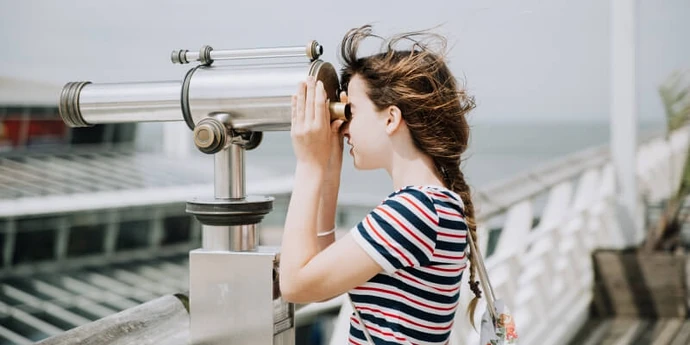Acceptance rates for jobs at the FAANG tech companies tend to be under 1%. As you can imagine, most candidates don’t get past the resume screening.
To increase your chances of getting to interview stage, use our step-by-step guide to writing a top technical resume/CV.
Get tips and expert insights from tech recruiters including 11 REAL EXAMPLES of tech resumes that earned candidates offers or interviews at FAANG (or "MAANG") companies such as Google and Meta.
Here’s an overview of what we’ll cover:
1. 7 golden rules for tech resumes (from FAANG recruiters)
2. 6 key skills for your tech resume
3. 11 examples of tech resumes that worked for Google, Meta, etc.
4. Tech resume template
5. How to write a tech resume that gets you into FAANG (section-by-section)
Let’s get into it.
Get expert feedback on your resume with tech ex-interviewers
1. 7 golden rules for tech resumes (from FAANG recruiters)
We asked Cody (top tech recruiter, ex-Google now at LinkedIn) and Candace (career and resume expert) what advice they'd give to someone writing a resume to get into FAANG/MAANG or similar.
They've helped a LOT of people get into FAANG and they evaluate tech resumes every day, so they know what they're talking about. This is what they came up with:
Tip #1 Answer recruiters' questions immediately
There is one thing that all recruiters and hiring managers want to know immediately: years of role-relevant experience.
And if you're applying for a management role, they'll also want to see how many years of management experience you have.
So, make it easy for them.
"Us recruiters are lazy. Don't make us dig around for the key info, we want to see if you meet the job requirements in the first 10 seconds!" says Cody.
To do this, you could include some bullet points with this key information at the top of your resume. This leads us to the next point...
Tip #2 Consider a non-traditional structure
The layout we recommend in section 4 is the traditional one, perhaps the safest. But it's not obligatory.
Cody prefers using two bullet-point summaries at the top of your resume to pack in the key information and your most impressive career achievements.
"The top of the resume is the prime real estate. Put the shiny bits, your best achievements, up top. That way you've got a better chance of grabbing the recruiter's attention."
This is what it looks like on page 1 of his resume:
Click to watch Cody's full explanation of this non-traditional resume format.
Tip #3 Avoid using design features
Unless you’re a product designer, and so there really is no upside to using a fancy resume design. It won't impress recruiters and, in a worst-case scenario, could actually prevent your resume from being properly processed.
"Design features like pictures, columns, photos, etc. can prevent ATS systems from correctly scanning your resume" says Candace.
You should also avoid including your photo in your resume, as this goes against employment and discrimination laws in most countries, and is another potential problem for ATS systems.
Tip #4 Be explicit about the locations you’re open to working at / remote
So many people fail to do this. But if FAANG recruiters are going to approach you for roles, rather than the other way around, they'll need to know the locations you're available to work at.
If you're willing to relocate for the right role, make that clear in your resume. So, instead of putting "San Francisco" under your name next to your email, maybe you put "Locations: San Francisco| Remote| Hybrid within a 30-mile radius of Bay Area".
Tip #5 Cut out all waffle
Recruiters like Cody and Candace see so many personal statements or 'objective' sections at the top of resumes which take up valuable space without saying much at all.
"Everything on your resume needs to be specific", says Cody. "Putting Experienced engineer passionate about making great products" doesn't tell me anything. It wastes both space and seconds of the recruiter's time. You've got to be more specific. How many years experience? What great products have you made?"
Tip #6 Numbers tell a better story
This is worth repeating again and again: quantify your achievements. All the most effective resumes are packed full of metrics and numbers that put achievements in context.
"Especially in engineering but honestly this advice is for many careers spanning many industries, we have to tell our story through data and numbers. Words can tell a story but numbers tell it way better" says Cody.
So, if you launched an app, say how many downloads it got. Or how many days ahead of schedule you launched. If you managed a team, say how many people were in it. Without numbers, your achievements are hard to evaluate.
Tip #7 Use a skills section to include keywords for your role
You don't want to jam your resume full of keywords, but with ATS systems increasingly used, it is important to make sure your resume mentions the necessary skills, tools and technologies. Candace says that a skills section can be a great place to list all these very efficiently.
"A "Skills" section can help recruiters quickly see if you fit their requirements, and is also a great way to get keywords into your resume. You could also consider a ‘technology snapshot’ type section if the jobs you’re applying for require experience in specific technologies."
For role-specific examples, check out our guides on product manager resume keywords and software engineer resume keywords that ATS and recruiters look for.
2. Key skills for your technical resume↑
The exact skills that you'll need to focus on in your resume will obviously depend on your role and the job description. But there are some key skills that are important in any tech resume:
1. Leadership skills, even if you're not applying for a leadership role. Recruiters and hiring managers want to see that you can have what it takes to become a leader if you're not one already. If you haven’t got many strong examples from your work experience, try to find examples from personal projects or university (if recently graduated).
2. Communication skills are desirable even for very technical roles. Try to include experience of working with cross-functional teams. If you're applying to a management role, demonstrate that you have experience aligning different stakeholders.
3. Data analysis skills. If you're an engineer, you'll work with data when optimizing performance, debugging, enhancing user experience, and monitoring software applications. Meanwhile, if you're a product or program manager, you'll need to use data to make crucial decisions in line with business objectives. Make your resume data-driven by quantifying success on past projects in terms of key metrics.
4. Facilitation skills. If you're applying for a management role, you need to show you'll be able to help your team progress, removing obstacles and solving blockages. It’s not always easy to get into this kind of detail on a resume, but try to include an example that shows how you unblocked a project, took preemptive action to avoid a bottleneck, or improved a process.
5. System design skills are usually needed for engineering roles at FAANG. You'll need to be able to discuss engineering architecture and make decisions relating to efficiency, scalability, and performance. So if you have any experience in designing systems, or related experience, make sure it’s prominent on your resume.
6. Engineering skills. This is obvious if you're an engineer, but can also apply to non-technical roles: companies such as Google expect product managers to have solid engineering chops: you’ll want to show that you can understand the sorts of problems that engineers face and are able to consider technical trade offs with them. Some companies will ask PMs for basic coding skills.
Demonstrating these skills on your resume should signal to recruiters and interviewers that you have the right capabilities they're looking for.
Right, let's see some example resumes.
3. Eleven examples of tech resumes that worked for Google, Meta, etc.↑
Before we start guiding you on how to write your resume step-by-step, take a look at some real examples that got their owners interviews at FAANG and other top companies.
You'll notice they follow different formats, and none fully follow the guidelines we set out below in section 5. We think this shows two things:
- there are many acceptable ways to write a resume
- your resume doesn't have to be perfect, as long as it demonstrates your skills and achievements effectively.
Let's take a look.
3.1 Tech resume example 1 (Amazon SDE)
The candidate, let's call him Sunil, got interviews for a Senior Software Development Engineer role at Amazon with this resume.


Here's our feedback on this resume:
- Experience: We had to blank them out, but Sunil had worked for some really top tech companies. This is what makes the resume really strong.
- Quantifying impact: Sunil could perhaps enhance his resume by better quantifying his actions and demonstrating their impact. For example, he says he "Revised Telemetry dashboards to improve signal-noise ratio". How much did he improve it by? Including specific metrics more often would take this resume to the next level.
- Key skills: Sunil lists key skills and tools that were likely listed as requirements in the job description. This makes a recruiter's life easier.
3.2 Tech resume example 2 (Amazon SDM)
The resume below is from "K". It got her interviews for an SDM role at Amazon.




Here's our feedback on this resume:
- Adapted for target company: K knew that her experience with AWS Cloud engineering would be important to Amazon and so she puts it right at the top.
- Tools & technologies: K demonstrates experience with a vast number of engineering technologies.
- Length: This is a 4-pager! She got the interview anyway, but K would have helped recruiters by cutting it to two pages.
3.3 Tech resume example 3 (Google SWE)
This is a great example of a strong fresher FAANG resume. It got "Ana" interviews at Google despite having almost no professional experience.


Here's what Ana does well on this resume:
- Education first: Ana doesn't have much work experience so she starts with Education, detailing specific topics in both her undergraduate and Masters courses.
- Projects: As a fresher candidate, Ana does well to list some relevant Projects to fill the gap where more experienced candidates would list recent employment.
3.4 Tech resume example 4 (Meta EM)
The resume below successfully got Dario (not his real name) into Meta, after he worked with coaches on our platform to ace the Meta EM interviews.

Here's our feedback on this resume:
- Highlights only: Every bullet point is impressive. Dario no doubt had plenty more achievements he could have included, but he cherry-picks the most impactful and packs them all into one page.
- Quantified impact: Dario uses numbers to clearly demonstrate the impact his actions had. He always uses at least one metric.
- Skills: Without taking up much space, Dario lists key EM skills and tools that he's experienced with, for the benefit of both recruiters and Applicant tracking systems.
- Action verbs: See how many of the top bullet points begin with "Launched". This helps Dario immediately convey that he played a key role in these big product launches. Elsewhere on the resume, he begins with other powerful verbs: "Grew", "Built", "Founded", "Reduced"."
- Consistent formatting: Dario doesn't try to do anything clever with the resume's design, but he makes sure the formatting is 100% consistent. The layout is simple and easy to read, and the use of green for the role titles works well.
3.5 Tech resume example 5 (Twitter/X EM)
This is another real example from an engineering manager. The candidate used it to get an offer from Twitter, now "X.com".
Note that some details have been anonymized in order to protect the candidate's privacy.
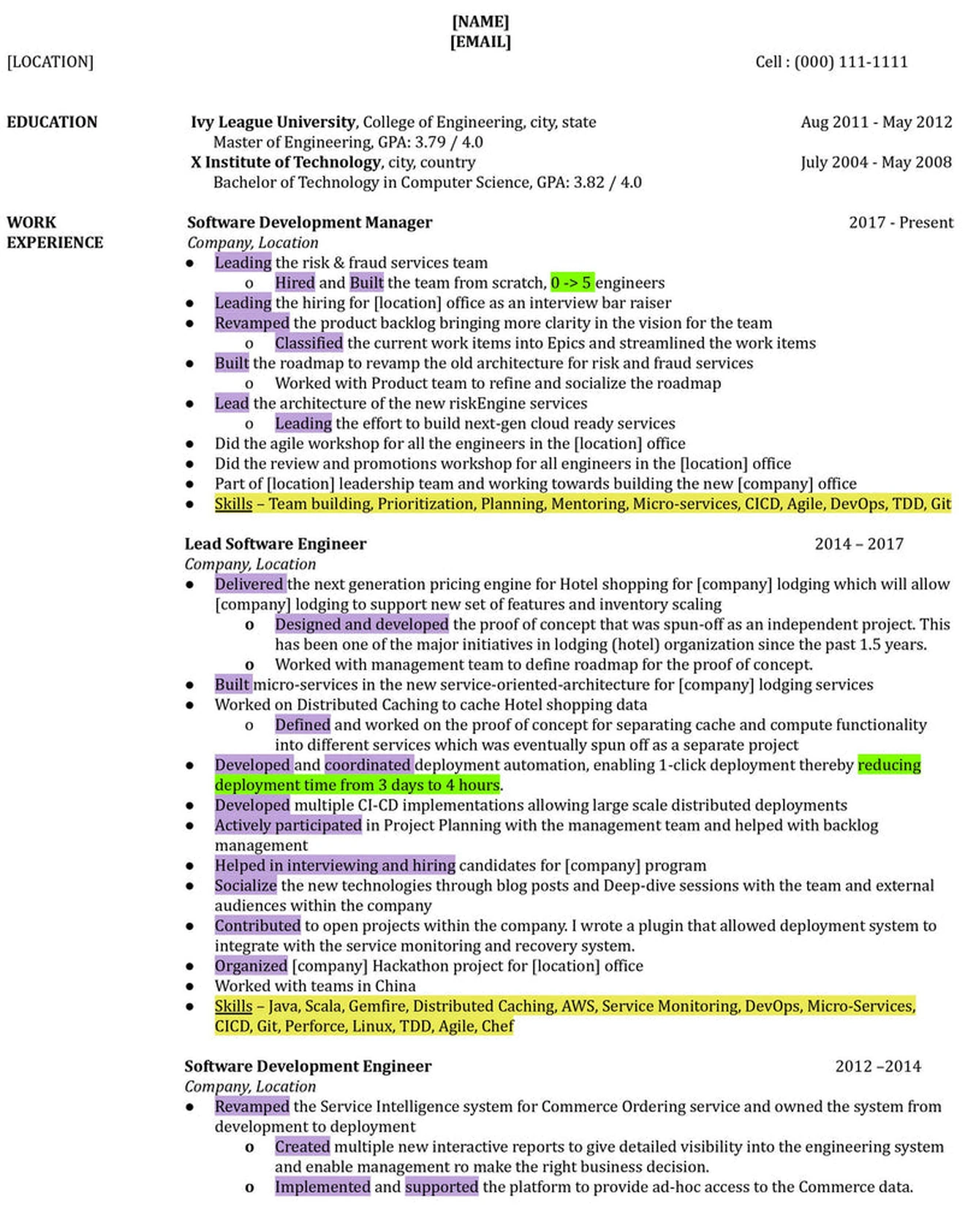
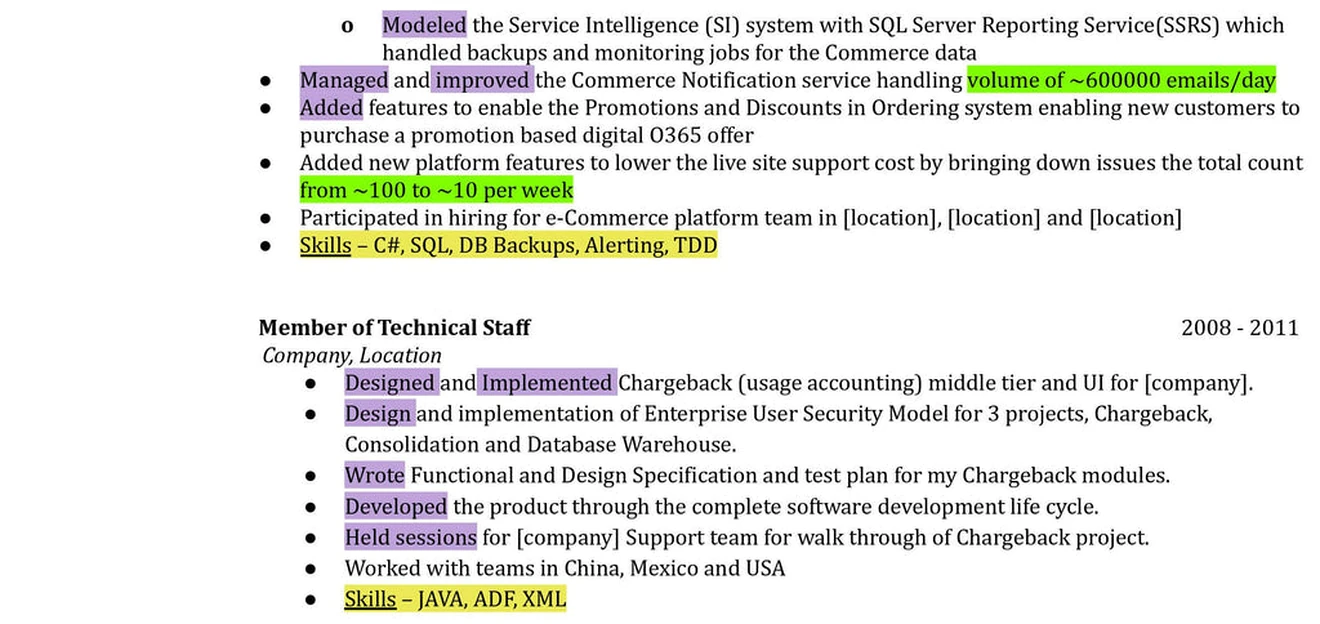
The candidate communicates his work achievements in a way that is very clear to understand. He does this via:
Action verbs: the candidate starts each sentence with a powerful action verb that reflects key EM responsibilities and skill areas
Quantifying achievements: he provides metrics to make his achievements measurable and specific.
Evolution of skills: he lists the skills he used in each position, to show how he has evolved and which skills he has used most recently
3.6 Resume example 6 (Walmart, Deliveroo EM)
This resume got Biswajit interviews at Deliveroo and AppSmith as an engineering manager. It also earned him interview invitations from Walmart and Veeva.


Here's what stood out for us on Biswajit's resume:
- Quantifying achievements: Biswajit is very detailed and specific in quantifying his achievements. For instance, he talks about building a "32-member team" with a "91% retention rate", which is more powerful than a "large team" with a "high retention rate".
- Key skills for the role: Throughout the document, Biswajit demonstrates key engineering manager skills; developing a team, cross-functional collaboration with different stakeholders, setting goals, building roadmaps, etc.
- Brevity: Biswajit does well to fit his resume onto 1.5 pages, despite having 16+ years of experience to talk about.
Click here to see more engineering manager resume examples and tips
3.7 Example resume 6 (Google TPM)
This candidate, let's call her Nadia, got a Technical Program Manager job at Google with this resume.
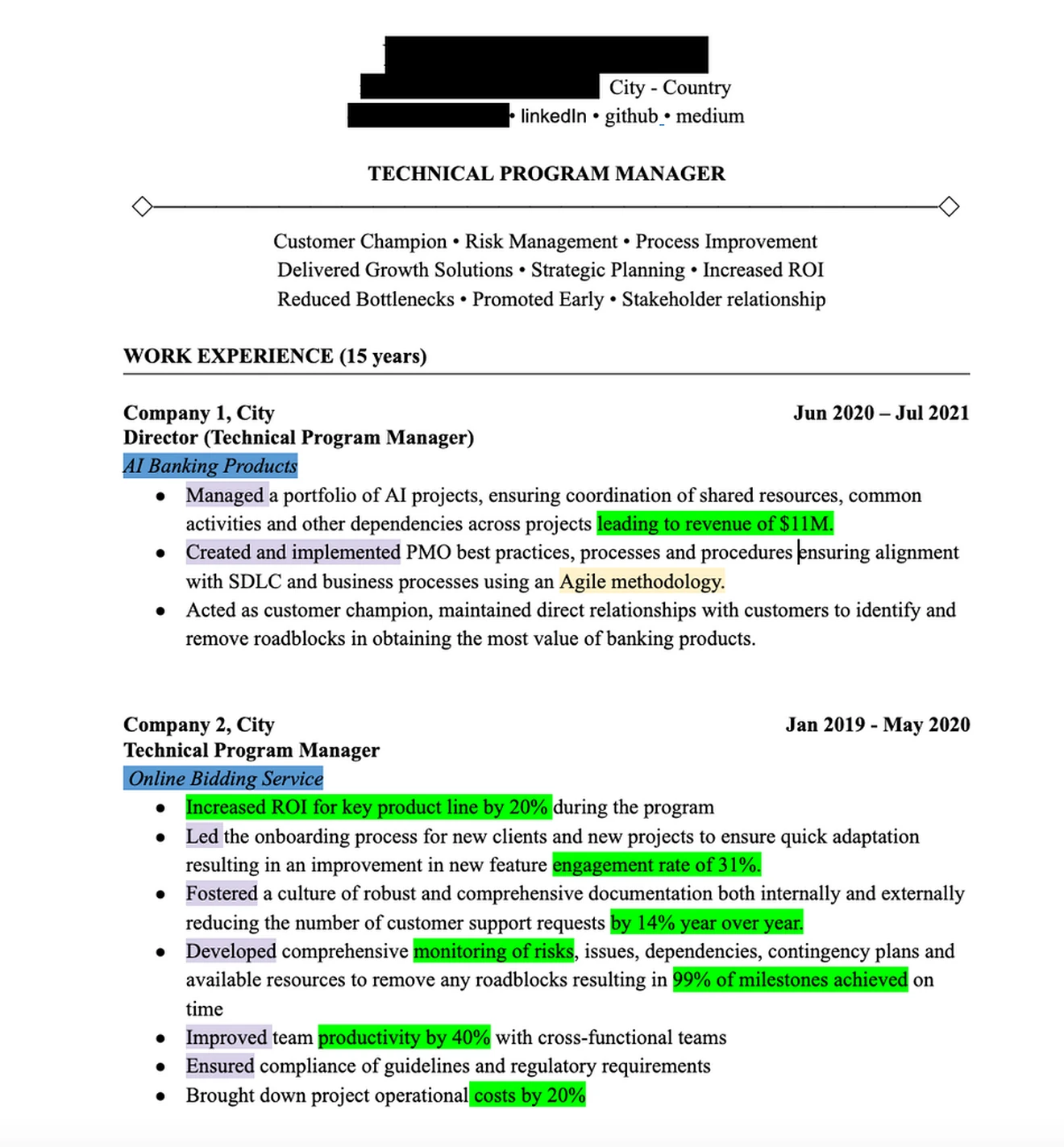
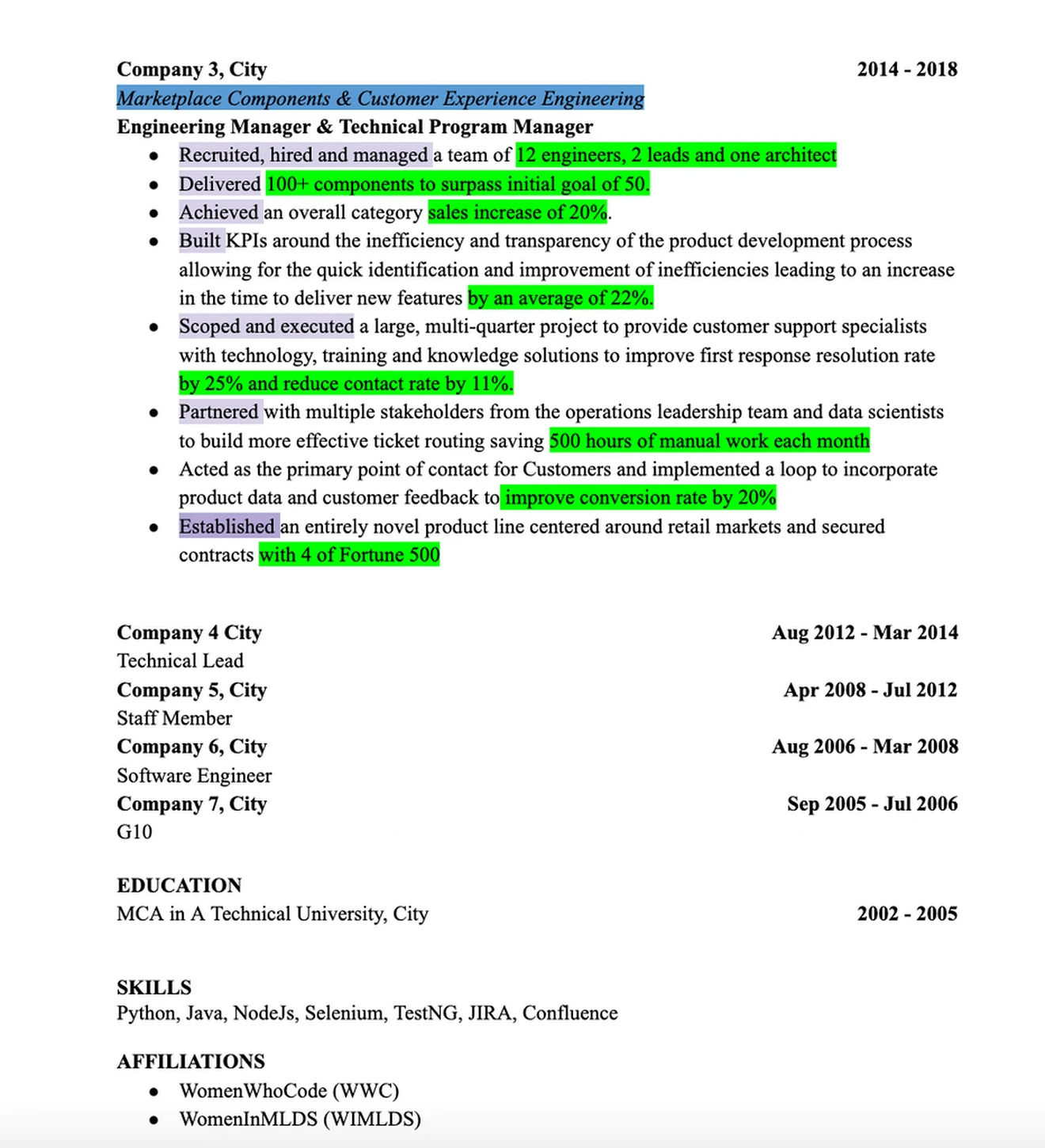
Nadia communicates her work achievements in a way that is very clear to understand. We've highlighted some of what she does well:
- Explanation: her previous company may not be well-known to the recruiter, so she adds a brief explanation.
- Action verbs: the candidate starts each sentence with a powerful action verb that reflects key TPM responsibilities and skill areas.
- Quantifying achievements: she provides metrics to make her achievements measurable and specific.
- Key skills for the role: Agile methodology was listed in the job description so the candidate made sure to include it near the top.
Click here to see more TPM resume examples and tips
3.8 Tech resume example 8 (Google front-end developer)
The resume below is from "Lana". It got her interviews for a front-end developer role at Google.


- Skills: Lana lists her relevant hard skills in a way that's very easy for a recruiter to understand at a glance.
- Languages: Don't make the mistake of thinking languages aren't relevant for a technical job. Lana's five languages signal that she's a strong communicator and helped her get an interview.
- Impact: Lana doesn't include examples of impact and results that she's achieved at work. Doing so would have greatly improved this resume.
3.9 Tech resume example 9 (CrunchyRoll Android Developer)
This resume got Sam (not his real name) interviews at CrunchyRoll for a Senior Android Developer position.


Here's what we liked about Sam's resume:
- Structure: Sam lists his technical skills, including programming languages, at the top.
- Impact: His work achievements are mostly well-quantified. E.g. 'increasing... downloads by 80% in 2 months."
- Action verbs: He always starts the bullet point with powerful action verbs such as "Created", "Designed", "Fixed", etc.
3.10 SWE resume example 10 (Audible, iOS engineer)
The below resume belongs to Jerry, an iOS engineer who at the time of writing was interviewing at Audible.


3.11 Amazon software development manager resume (expert)
The resume below is from an Amazon SDM who is also a interview and resume coach on our platform. It's not the resume that got him into Amazon, rather it's his current resume.




Here's what our coach, let's call him Amar, does well in this resume.
- Quantified impact: He gives specific numbers and metrics to clearly state the impact of his achievements.
- Clarity: Most of the bullet points are 1 line, maximum two. There is plenty of white space and it's extremely easy to read and understand.
- Open-source contributions: It's great to include these on a resume as it shows you're passionate about engineering and suggests a collaborative mindset.
4. Tech resume template↑
Unlike the examples listed above, this is not a real resume. Instead, it's an amalgamation of the many high quality resumes that candidates have shared with us before going on to work at Google, Meta, Amazon, etc.
It belongs to an imaginary mid-level software engineer called Karl, but you can follow the overall structure no matter what you're role is.

Click here to download this tech resume template as a PDF
Click here to open this tech resume template as a google doc
Right, let’s take the first step in building a tech resume that's good in enough to get into FAANG.
5. How to write a tech resume that gets you into FAANG (section-by-section)↑
Now that you’ve seen examples of what you should be aiming for, as well as some key tips, let’s go through the resume-building process, step-by-step.
5.1 Study the target company and job descriptions
Before you start writing or editing your tech resume, our tip is that you do some research.
Find a job specification for the sort of FAANG role you’re targeting, read it thoroughly, and use it to shape your resume in the following ways:
- First of all, work out what type of tech profile is the job description is looking for. Which skills will be most crucial for the role? Prepare to adapt your resume’s content accordingly.
- Zoom in on a few of the responsibilities in the job description that you think are most important. Search for specific examples from your past that demonstrate experience in doing the same thing or something very similar. Find the numbers to back it up where possible, so you’re ready to include this information in the work experience section later on.
- Take note of the language used in the job description so you can, where appropriate, match specific verbs and phrases.
- Research the company. For example, imagine you’re targeting a SWE role at Meta. Meta has 6 core values, so you’d want to make sure that your resume transmits these values too, or at least doesn’t contradict them. That could mean including a volunteering activity under Interests to show that you like to "build social value." Follow the same logic if you’re applying for Google or Amazon.
Does all this mean you’ll need a different iteration of your resume for every tech job you target?
Ideally yes, but there will be a lot of overlap, so usually you’ll only need to make a few strategic edits.
5.2 Choose a design
The design of your resume should have one objective: to convey as much information as possible in a way that is clear, easy to digest, and professional. Use our resume template as your template, and you’ve already achieved that!
Some people add a second objective: to demonstrate strong design skills to stand out from the crowd and impress the recruiter.
However, some recruiters might even be put off by a “creative” or unique design and, in a worst-case scenario, it could prevent your resume from being properly processed.
Keep it clean and simple. You should also avoid including your photo in your resume, as this goes against employment and discrimination laws in most countries, and is another potential problem for ATS systems.
5.3 Choose your sections
There are lots of ways to write a resume and the exact sections you include are up to you. We recommend using the following sections for a tech resume because we know this approach works for companies such as Google, Meta, and Amazon, for both junior and experienced candidates.
- Personal information
- Work experience
- Education
- Skills/Tools
- Interests/Extracurricular
You may want to tweak the order. For example, if you’ve just graduated or have just a year or two of experience, Google recommends starting with your education section.
5.4 Start writing!
The good news is, you don’t have to get it perfect first time. A strong resume is usually one that is re-written and tweaked multiple times.
We’ve spoken to tech recruiters to get guidance on how to write up each section. Let’s take a look.
5.4.1 Personal information section
This section is not the place to try and impress. Just make sure you get your key details across as concisely as possible.
DO:
- Use a bigger font for your name than for the rest of the section to make it stand out
- Include your name, email address, phone number, city/county you live in
- Ideally, include a link to your LinkedIn profile (or Github if you have an engineering background)
DON’T:
- Title this section. It’s not necessary in this type of layout, so save the space
- Include a street address, it’s unnecessary and unsafe
- Include a photo, date of birth, or gender, unless specifically requested to do so
- Label each piece of information e.g. “email:”, “tel:”, etc. It’s obvious what they are, so save the space
5.4.2 Work experience section
This is probably the most important part of your resume to get right, and the easiest to get wrong. Many candidates think that their work experience speaks for itself, and simply list their role and a few of their main responsibilities.
However, we recommend a much more powerful approach.
Instead of listing responsibilities, you need to talk about actions. This means starting each bullet point with an action verb. These verbs should relate to the key skills from section 1 that companies look for in tech resumes (Leadership, Communication, Facilitation, Data analysis, etc). "Executed," "Unblocked," "Led," and "Delivered" are some good examples of such verbs.
Choosing actions that are relevant to the essential tech skills will also mean that your resume contains the keywords that recruiters (and sometimes Applicant Tracking Systems) will be looking for.
You should also focus on the results of what you did and quantify them as much as possible to highlight the tangible contributions you have made. Ex-Google SVP Lazlo Bock talks about a common method for doing this that you might find helpful, called the “X, Y, Z” formula:
“Accomplished [X] as measured by [Y] by doing [Z]”.
For example, “Decreased server response time by 30% by implementing machine learning implementation”.
Finally, balance can be very important if your target role is multi-faceted, such as engineering manager, or TPM. If so, try and demonstrate a range of skills in the work experience section.
DO:
- Use reverse chronological order, putting most recent employment at the top
- Use present tense verbs (e.g. "Lead, Coordinate, Execute") in your current position (except for completed achievements), and past tense verbs for past positions and completed achievements (e.g. "Led, Coordinated, Executed")
- If you're an engineer, consider including the programming language you used for each project (Google's recommendation)
- Describe your actions and what they achieved
- Include metrics to quantify what your actions achieved where possible
- Study the language of the job description and where appropriate, match it
- Make sure you’ve naturally included several relevant keywords
- Demonstrate a balance of skills
DON’T
- Be shy and humble. Now is not the time!
- Just put your responsibilities
- Be vague
- Go so overboard with numbers that it looks like a math problem. It still needs to be easy to read
- Include lots of buzzwords just for the sake of it
5.4.3 Education section
This section should be extremely concise and clear. Hopefully your educational achievements can do the talking for you, as all you can really do here is present the necessary information with the right level of detail.
Note that if you have recently graduated and only have internship experiences instead of relevant work experience, this section should follow the Personal Information section, and you may want to go into a bit more detail. Otherwise, you can include it after work experience.
Follow the tips below to make sure you get it just right.
DO:
- If you have multiple degrees (e.g. a BA and an MBA), you should write a subsection like the one above for each degree, starting with your highest level of education first (e.g. your MBA)
- For each degree, include the name of the degree, university, and dates in the headline. If you’re a recent graduate, you can also list any subjects you have taken that are relevant to product management (e.g. design, coding, entrepreneurship, data analysis, etc.)
- List your grades (e.g. GPA) as well as results of other standardized tests you have taken (e.g. SAT, GMAT, etc.) that demonstrate your intellect
- Detail any awards and scholarships you received at university level and most importantly how competitive they were (e.g. two awards for 1,000 students)
- If you don’t have much tech work experience you might want to include tech bootcamps (e.g. General Assembly) and link to your projects, or online courses (e.g. Udacity)
DON’T:
- Panic if you don't have a degree. You don’t have to have gone to college to get into a FAANG company. Instead put your high school grades and any relevant educational qualifications you gained after school
- Include high school experience if you've already graduated
- Include your thesis / dissertation unless you're a fairly recent graduate, in which case you should summarize the topic in a way that's VERY easy to understand
5.4.4 Awards and Leadership section
We've labelled this section "Awards & Leadership" instead of "Extracurricular" section for two reasons:
1. Google uses it as its recommended resume template (see here)
2. Extracurricular activities are less important for technical roles like software engineer.
The more experience you have, the easier it should be for you to find two or three strong bullet points that demonstrate leadership (outside your day-to-day work) or awards.
If you haven't won any awards or can't think of any strong leadership examples outside your day-to-day role, then consider leaving out this section entirely.
DO:
- Put awards in context. E.g. "1st out of 22 applicants".
- Consider leaving this section out if you're lacking content.
DON'T
- Use awards from school or university if you graduated more than ten years ago
- Include weaker achievements (e.g "employee of the week") just to fill space
5.4.5 Additional Skills & Interests section
A technical resume needs to show that you're adept at using a wide range of tools, methodologies and technologies. Listing them here can make it easy for a recruiter to quickly check you meet their requirements.
DO
- If you need to save vertical space, list skills in sentences rather than bullets
DON’T
- Include generic, uninteresting things that everyone likes doing, like “watching Netflix” or “hanging out with friends,” as interests
- List basic skills that almost everyone has, such as "google docs" or "Ms word".
5.5 Proofreading and feedback
Don’t skip this step! Use a grammar checking tool and then proofread until it’s perfect. This is harder than it sounds because multiple reviews and tweaking after the initial proofread can easily create new hard-to-spot errors. The only solution is to proofread again after each tweak.
We recommend saving as a pdf file unless the job description says otherwise, and checking it opens properly (with the correct formatting) on a Mac or PC.
Receiving feedback is also important. Share it with a friend or partner, and they’ll be very likely to see mistakes that you haven’t noticed. Of course, if you can share it with an experienced tech recruiter / interviewer, that can give you a big advantage over other applicants.
DO
- Proofread from top to bottom and then read it in reverse to check spelling
- If you’ve tweaked it, proofread again before sending
- Check the file opens properly on Mac and PC
- Get feedback on it before sending
DON’T
- Send it with typos. Your resume is your product!
6. Your tech resume checklist↑
Almost ready to send your technical resume? Use this checklist to make sure you’re following the best practices we’ve recommended above.
If you can answer “Yes” to every question, then you’re ready to hit "Apply" or upload it to a popular technical jobs site.
General
- Does your resume present you as the type of candidate the job description is looking for?
Layout
- Is it just one page? If not, do you have the experience to merit 2 pages?
- Is the formatting 100% consistent and neat?
- Is there enough white space to breathe?
Personal Information
- Have you checked your contact details are correct?
- If you're an engineer, have you listed your programming languages?
Work Experience
- Have you talked about your actions rather than your responsibilities?
- Have you quantified the impact of your actions?
- Have you demonstrated a range of relevant skills?
Awards & Leadership
- If you graduated >10 years ago, are your examples post-university?
Skills & Interests
- Have you listed all the programming languages and relevant tools you’re familiar with?
- Do your interests make you stand out from the crowd in some way?
Proofreading and feedback
- Have you proofread since you last edited it?
- Have you received any feedback on your resume and updated it?
- Have you saved it as a PDF to make sure it displays correctly on all devices?
Did you say “Yes” to every question? Well done! If you’ve used all the tips in this article, then your resume should be in good condition and will give you a fighting chance of getting a job at a big tech company.
7. Is your resume good enough for FAANG?↑
If you're going for one of the top tech jobs, having a resume that's "fine" may not be enough. To get your tech resume from "fine" to "outstanding" usually requires feedback from someone who really knows their stuff - as in an ex-recruiter or manager at one of the top companies.
We know it's hard to get access to those types of people. That's why we've created a resume review service, that allows you to get immediate feedback on your resume with a top recruiter/coach of your choosing. Take a look!








